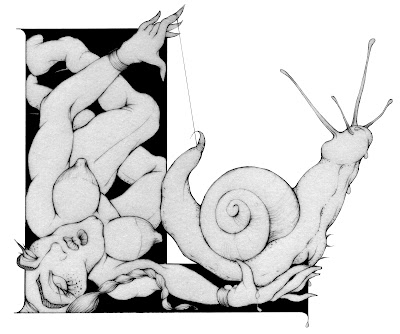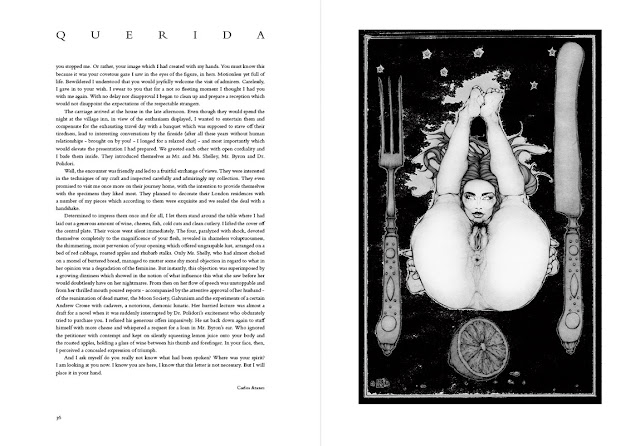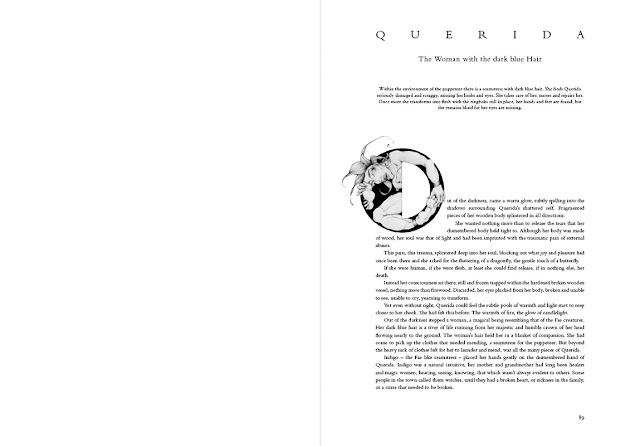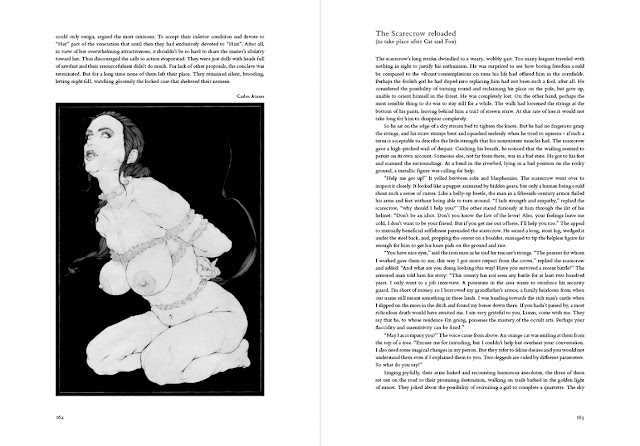
Q U E R I D A
A Doll's Tale of Misery and Liberation
"Querida" is an illustrated narrative about a puppeteer who constructs a
female puppet which he has act out erotic scenes as a pastime.
She
is shaped in the likeness of his truelove, his cousin who passed away
untimely. An exceptional piece of work, her limbs and eyes are
masterpieces, crowned by her hair which is made from the human hair of
the cousin herself. The puppet wakes to conscious and sensual
perception. It - now she - realizes that she is the subject of these at
times humiliating scenes and develops the ability to actively manipulate
the action.
She soon discovers that certain circumstances enable her to let her
doll's body actually come to life for limited periods of time.
Her contempt for the hated puppeteer ultimately leads to his murder.
It is a highly erotic Graphic Novel, with an essential amount of text,
about 170 pages with 50 full page illustrations, to be checked out in a
comprehensive free preview here, scoll down to "pages".
For this project, I called together a small number of authors and
authoresses, some of them writing their cameo chapters under a Nom de
Plume.
Most of the episodes were written by the Spanish film
director and playwright Carlos Atanes. I was very happy to be able to
work with him once again. His input to the story was huge, giving it his
own unique, imaginative and sensual tone.
Interspersed are cameo chapters written by other authors. It especially
was a great pleasure to work with Madison Young, a pioneer of the
feminist porn movement. She contributed four lovely chapters.
You find an erotic fairytale with a few tongue in cheek references to
books/novels dealing with the subject of artificial human creatures,
such as Carlo Collodi’s "Pinocchio", E.T.A. Hoffmann's "Sandman" and
works of E.A. Poe and Mary Shelly, playing with the sexual connotation
the original Pygmalion theme has always been charged with.
“Outstanding
… an absolutely seamless, yet fragmented piece of flowing fabulist poetry; a
transgressive fable … The story is so blunt, yet contains enough poetry where
the reader can project their own emotions and meaning to it.” Gabriel Hart
“I felt
parallels to the Artificial Intelligence conversation, the feminist conversation,
the trauma conversation, the trans conversation (as far as being uncomfortable
in your own body, feeling hostile to your maker), I could go on and on.” Gabriel Hart
“It evokes
in mind the mythological story of Pygmalion and Galatea along with the Sandman
novel by Hoffmann. Nevertheless, the main text for Querida to follow is The
Adventures of Pinocchio by Carlo Collodi. The whole book pays homage to
this famous tale on the level of its cast: the doll becoming a human, the
talking cricket, the fairy with blue hair, the deceptive duo of a fox and a
cat, the coachman, Mangiafuoco, etc. The cardinal difference between the two
narratives is that Querida disgusts her master and kills him at the end of the
story.” Darya
“Querida's
dreamy visions and metamorphoses of shapes and sizes in the tale unavoidably
bring to mind the books of the English mathematician who fell in love with his
little pal Alice Liddell.” Darya
“The
illustrative part of the book is represented by black and white or red depictions
of the doll. The first letters of each chapter are decorated with her figure as
well. Curiously, van Rijn's manner lies in portraying women as liberated and
independent creatures, much closer to Lilith than to Eve. Unlike the heroine,
the character of these images doesn't look helpless in any scene but
aggressively sexual.” Darya
“The book is a curious example of group activity with all apparent pros
and contras of this approach. Contras, as discussed above, mainly consist in
the absence of integrity of personalities. The book is similar to a patchwork
blanket. On the one hand, it makes the plot tough to follow, which is rather a
disadvantage; on the other hand, which is among the pros, the reader can
compare different literary approaches and choose a favorite. The book is
recommended to the devotees of Jan van Rijn's work, as well as, considering the
thematic similarity, to the admirers of the oeuvres by Hans Bellmer. “ Darya



















































































